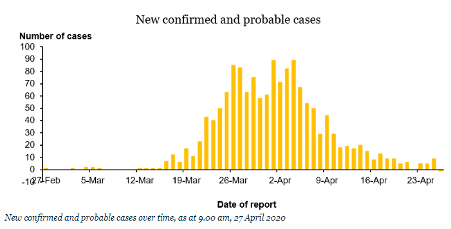How New Zealand and Australia are tackling COVID-19
Australia's famous Bondi Beach has re-opened to surfers.
Image: REUTERS/Loren Elliott
Explore and monitor how COVID-19 is affecting economies, industries and global issues
Stay up to date:
New Zealand
- Australia and New Zealand have a case-fatality rate of just above 1%, compared with 6% in the US and 13.5% each for Italy and the UK.
- Neither nation currently has community transmission.
- Both island nations still have their borders closed.
- Countries easing lockdowns are facing the new challenge of suppressing new cases.
Both New Zealand and Australia have worked hard to successfully contain COVID-19. The two countries are the latest to ease restrictions and craft a new normal while putting measures in place to reduce future transmission.
In New Zealand, there is strong evidence that widespread transmission has been avoided for now, and the strictest social controls have been lifted.
And while social distancing measures remain in place in Australia, some restrictions have eased. Additionally, citizens are downloading the government’s voluntary coronavirus tracking app that notifies them if someone they know has the virus.
Accept our marketing cookies to access this content.
These cookies are currently disabled in your browser.
Both countries have a case-fatality rate of just above 1%, according to data compiled by Johns Hopkins University, compared with 5.7% in the US and around 13.5% each for Italy and the U.K.
New Zealand has 0.4 deaths per 100,000 population and Australia has 0.3, compared with 17 in the US and 31 in the UK.
“There is no widespread undetected community transmission in New Zealand,” Ardern told a press conference. “We have won that battle, but we must remain vigilant if we are to keep it that way.”
In relaxing the restrictions, she said, the government’s aim was to open up the economy, but not to open up people’s social lives. The nation has a 4-level COVID-19 Alert System, and is now at level 3, down from the top level 4.
That means people are expected to “stay within their household bubble” but can reconnect with close family, bring in caregivers and support isolated people. Early learning settings and schools can reopen, but remote education will continue where possible, for example for older students.
Australia is also in the midst of a national emergency plan including social distancing and has closed its borders. To date, government data shows the majority of confirmed cases acquired their infection overseas, including on board cruise ships or on trips to Europe or the Americas.
Testing has been a key frontier for all countries battling the virus and the World Health Organization says finding and testing every suspected case will be essential to success. Australia has carried out more than 500,000 tests, the government website says.
What is the World Economic Forum doing about the coronavirus outbreak?
Ardern said New Zealand has one of the highest testing rates in the world per capita and together with moving slowly and cautiously this would help guard against a new wave. Not locking down so early and aggressively might have resulted in 1,000 cases a day, she said.
“We can look overseas and see that this devastating scenario has played out in other countries,” she said.
Countries easing lockdowns around the world are facing the new challenge to suppress new infections. Other nations where cases fell, including Singapore and China, have seen a rise after initial successes.

New Zealand is watching what’s happening in other countries, Ardern said, and will be particularly cautious and aggressive in the management of any future cases.
“This is a tricky virus,” said Dr Ashley Bloomfield, New Zealand’s Director-General of Health. “That’s why we’re not going to reduce our vigilance one bit.”
Don't miss any update on this topic
Create a free account and access your personalized content collection with our latest publications and analyses.
License and Republishing
World Economic Forum articles may be republished in accordance with the Creative Commons Attribution-NonCommercial-NoDerivatives 4.0 International Public License, and in accordance with our Terms of Use.
The views expressed in this article are those of the author alone and not the World Economic Forum.
Related topics:
Forum Stories newsletter
Bringing you weekly curated insights and analysis on the global issues that matter.
More on Health and Healthcare SystemsSee all
Mamta Murthi and Sania Nishtar
June 19, 2025
Naoko Tochibayashi and Mizuho Ota
June 18, 2025
Gaurav Ghewade
June 17, 2025
Gareth Francis
June 12, 2025






